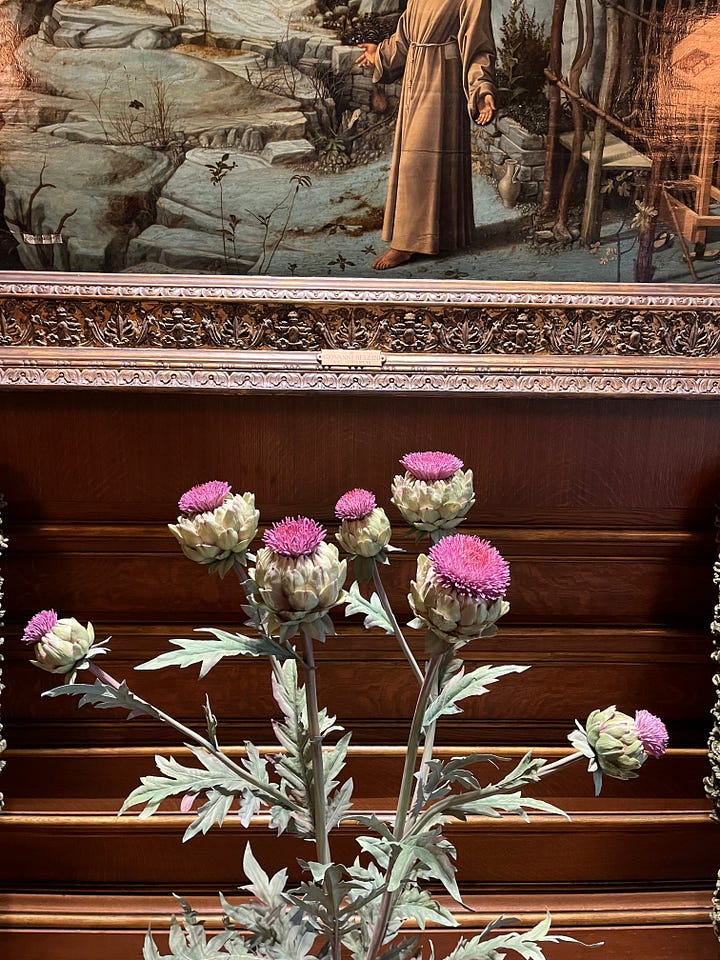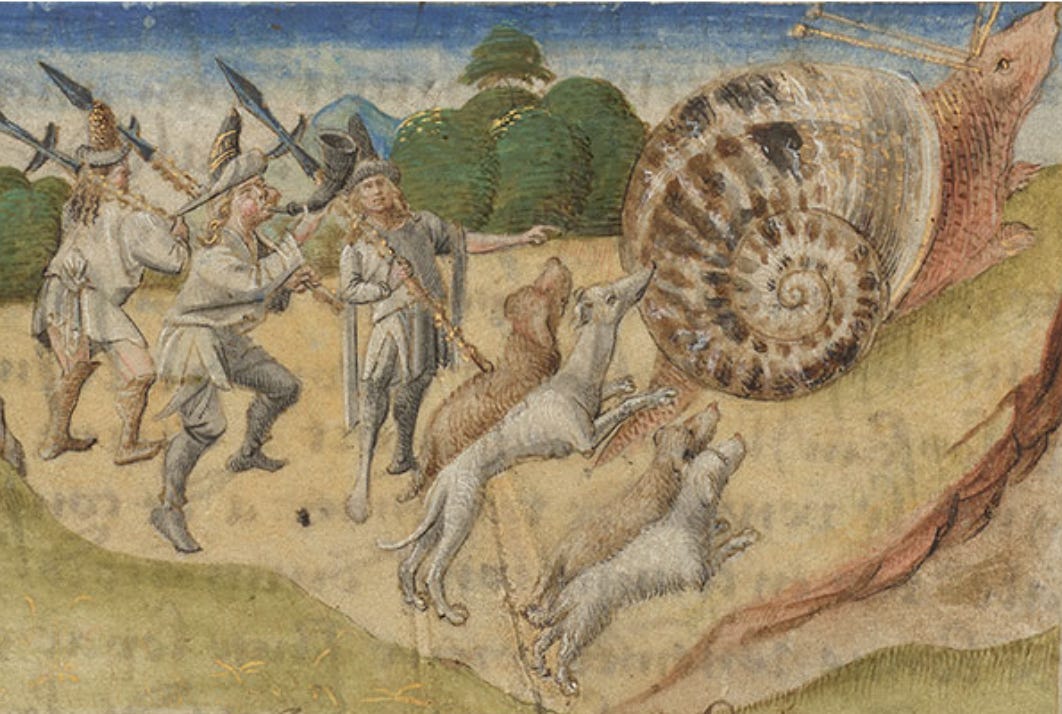Frills at the Frick, Medieval Manuscripts at the Morgan
It’s a good time to pop into the city’s house museums.

Perhaps you’ve missed the deluge of press and Instagram posts, but the Frick Collection has reopened in its original location in Henry Frick’s gilded age mansion on East 70th St. At the Morgan Library in Midtown, former home of J.P. Morgan, there’s a tiny but beautiful exhibition of medieval manuscripts and the weird ways that the era perceived travel and foreignness.
The New-ish Frick
At a preview day at the Frick, the halls were swarmed with curious art-people, peering into the newly-polished rooms and taking pictures in front of the rich fabrics and flowered wallpaper. The setting is certainly photo-worthy — a gilded age dream — and unfortunately it might outshine the art that it’s supposed to house.
The museum opened in 1935 in the Upper East Side home of Henry Clay Frick (1849–1919) to show his private collection of Old Masters, big-name European artists, and decorative arts. It closed in 2020 for an extensive renovation, with the paintings housed for a stint in the Breuer building on Madison Ave, a landmark previously home to the Whitney Museum and the Met Breuer (and soon to be Sotheby’s new headquarters).
The $220 million renovation on East 70th emphasizes the architecture and the setting: each room is sumptuously done, especially on the ground floor. Whether that makes for a great space to look at art is up for debate. The main event, a dark green velvet room housing Rembrandts and van Dycks, was positively frustrating. It’s a beautiful space, and you want to luxuriate in the ambiance of the room as a whole. But looking at the artwork itself is difficult. Not only does the green swallow up the dark-toned portraits in the room, but the light above each work throws a strong glare on the glass frames that makes it hard to actually see the painting up close. The same goes for two lovely Whistler portraits in the room’s entryway, with their delicate dresses lost in the room’s low-lit atmosphere. With such a high-profile renovation, it’s surprising the actual viewing of the artwork wasn’t prioritized more. Instead, it feels like focus was on the setting’s photo-op potential. Rather than highlighting the collection paintings, the lighting and room setup emphasizes the decor and new additions like the beautifully-done ceramic flowers flanking the artworks, created by contemporary artist Vladimir Kanevsky to emulate the opening of the original Frick in 1935. They are, of course, very photogenic.


Details like the flowers and the artwork lighting indicates that the Frick is aiming at an overall experience, rather than an art-focused one. And I’m not saying that’s bad — I took many, many photos of a delightful ceramic lemon tree in the glass-domed courtyard — but it’s different from the expectations I have for a museum, and I find it too distracting. I found myself missing the Frick Madison, temporary home to the collection: the brutalist building let the ruffles and lace of the artworks act as the star (my god - is this a defense of the white cube?). But in an age when museums are working hard to get in younger audiences and reach wider demographics, a photo-friendly “art experience” might be a savvy play.
As for the works themselves, the collection is enormous and reads almost like Western art history 101. Highlights include medieval Italian altarpieces and devotional works (shoutout to Fra Filippo Lippi), French Rococo painters like Fragonard and Boucher, and Northern favorites like Frans Hals and Hans Memling. As a Wolf Hall fan, I love the Hans Holbein portraits of Thomas Cromwell and Thomas More (unfortunately, More’s is the better portrait, with richer colors and fabrics. The lavish red sleeves!). And to be fair, it’s easier to spend some time with the art when you’re upstairs. The upper rooms were first the family living quarters, and then offices for the staff, and so are (marginally) less grand than the ballrooms below. The new rooms are an exciting part of the renovation — they’ve opened up more space, which means more of the collection can come out of storage and onto the walls. And truly, what a collection: it’s almost shocking when you remember that this was the personal collection of just one man, hellbent on obtaining works by the art history canon. (As my mother observed, “What an overly acquisitive person! Perhaps he needed some eastern religion.”)
All that’s to say, the new Frick is beautiful and something to be experienced. Decide for yourself whether the elaborateness of the setting outweighs the distraction from the works themselves. And if you do go, make sure to stop by the new research library. It’s truly exquisite — a Harry Potter-esque vision of carved mahogany tables and metal-studded leather doors.
(Mostly) Medieval Marvels
33 blocks directly south, the Morgan Library is one of my favorite gems. Another lavish home from a Captain of Industry with another impressive library to offer, the museum is leaning into its old-fashioned reputation with an exhibition centered around the 15th-century French illustrated manuscript Book of the Marvels of the World.

The Book is essentially an fantastical travel guide, demonstrating the wild and often funny misconceptions about the rest of the world (some may say the French still feel this way about all other countries that aren’t France). But the Book of Marvels wasn’t alone — complementing the Book are medieval (and slightly later) travel guides from all around the world: Germany, the Persian Empire, England, Italy, Turkey, and they each come with weird, delightfully-illustrated assumptions made about other cultures. As the Morgan puts it, “medieval conceptions of the world were often based more on authoritative tradition than direct observation.” Standouts include the tribes with only one foot and no heads that lived “to the east” of Germany, and a group of far-away Christians praying to a horned devil in a Turkish manuscript.
The visual appeal of medieval illustrations — colorful, recognizable, whimsical, occasionally gold-leafed — means that even when you’re looking at what’s supposed to be a group of blond Sri Lankan knights hunting snails the size of horses, there’s pleasure in the delicacy and care of the pattern on the snail’s shell.
Less amusing and more painful are the Spanish and French depictions of the Caribbean and Latin America. These were illustrations made from direct observation by colonial visitors, and the arrogance and casual cruelty in these cultural dismissals showcases a mindset of a people ready to wipe out and enslave entire populations.

You leave feeling some awe at how our view of the world has changed. There’s a map, typical of the era, that’s oriented pointing east instead of north, and it feels like a metaphor for the medieval worldview: their geographic locations might be the same, but these were people who looked at the world from a fundamentally different direction. Current geopolitics notwithstanding, we look at travel and foreign countries as something exciting, enviable, interesting. Medieval people from around the globe did not: foreign countries were full of monsters and terror. Judging by these illustrations, it would be infinitely preferable to not return to that mindset. Even one's own country was full of magic you couldn’t dare to understand: one Italian manuscript shows off baths healed due to a blessing from the ancient poet Virgil, who was considered a “magician” — underscores how the medieval world was full of magic and some foolishness in a way the ancient world was not. It was a frightening world in medieval times, full of magic and potential disaster. It’s of course still a frightening world, only now we are able to name the evils a little more.
All images courtesy of the rights holders





